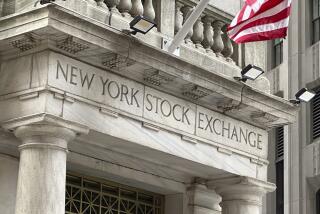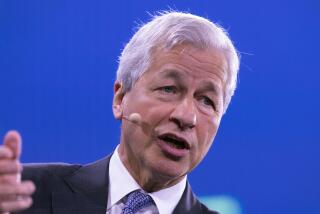In ‘92, Small Stocks Were Big : NASDAQ Issues--and Investors--at Giddy Heights
- Share via
Wall Street closed the books Thursday on a second straight winning year, with 1992 ending as it began--riding a boom in small-company stocks.
But many analysts warn that the “Clinton rally” of recent months now has stretched too far, and that stocks are vulnerable to a pullback.
“We’re getting too confident, too exuberant,” says Richard McCabe, manager of market analysis at Merrill Lynch & Co. in New York. “Between here and the next two or three weeks, I’d be trying to take some money off the table.”
The Dow Jones industrial average closed Thursday at 3,301.11, down 19.99 points for the day but up 132.28 points, or 4.2%, for the year.
Yet the Dow, which had jumped 20.3% in 1991, was more of a footnote than a benchmark in 1992, depressed by such deeply troubled blue chip stocks as International Business Machines and General Motors. At year’s end, the Dow was off 3.3% from its June 1 all-time high of 3,413.21.
Wary of aging blue chips but still desperate for better alternatives to 3% money market returns, investors increasingly turned during the year to stocks of small- and mid-sized companies--and were well-rewarded:
* The NASDAQ composite index of 4,000 mostly small stocks jumped 5.10 points Thursday to end 1992 at a record 676.95. For the year, the NASDAQ posted a 15.5% rise after surging 56.8% in 1991 on the heels of the U.S.-led victory in the Persian Gulf War.
* The Standard & Poor’s mid-cap index, which covers 400 companies considered mid-range in size, leaped 9.3% in 1992, double the 4.5% return of the blue chip S&P; 500 index.
Among other smaller-company stock indexes, only the American Stock Exchange market value index disappointed. Up just 1.1% for the year, it was held back by the poor performance of the many small energy and mineral stocks that trade on the Amex.
Despite small stocks’ impressive numbers for the year, most of their gains came in the first two months of 1992 and in the last three. Between March and September, most smaller issues suffered steep declines or simply went nowhere, stuck in a narrow trading range similar to the one that corralled many bigger stocks.
In fact, the S&P; 500 index traded in a range of just 11.9% in 1992, measuring the difference between its annual high and low. That was the narrowest range ever, S&P; officials say.
Why so little movement in the market overall? Mostly because investors were forced to play the waiting game for much of the year--waiting on lower interest rates, waiting on the slow economy, waiting on the election.
By early October, however, Wall Street accepted Bill Clinton’s ascendance to the presidency as a sure thing, and took seriously his promise of solid economic growth ahead (which investors translate as solid corporate earnings growth). Ever since, stocks have been rallying with only minor interruptions.
But investor optimism now has reached giddy heights, many analysts warn. The American Assn. of Individual Investors’ weekly poll of members shows 60% bullish, an extreme level that usually heralds a near-term peak in stocks.
“I think we’ll hit a top fairly soon, go through perhaps a 10% correction, then start moving up again later” in spring or summer, says Arnold Kaufman, editor of S&P;’s Outlook newsletter.
Though the economy appears on solid footing, Kaufman notes that stocks are trading near record price-to-earnings multiples, leaving little room for unforeseen shocks. “And you know there is going to be some disappointment somewhere early in 1993,” he says--either with Clinton, the economy, corporate earnings, foreign crises or some combination of them all.
Still, Wall Streeters generally believe that investors should look forward to playing the same trends in 1993 that dominated in 1992:
* Small stocks should continue to lead the market. Many small firms proved in 1992 that they can earn decent money even in a sluggish economy. Their performances look that much better as the list of fading blue chips grows longer--IBM, GM, Westinghouse, Sears, etc.
And if the U.S. economy picks up as expected this year while growth remains slow in Europe and Japan, small companies have another advantage over blue chips: Small-company fortunes are mostly tied to the domestic economy, while multinational blue chips would be hampered by overseas disappointment.
“I think we’re in a multi-year (up) cycle for small stocks,” says David Shulman, market strategist at Salomon Bros. in New York. But, he adds: “I think this rally is ahead of itself.”
* Stocks that are sensitive to the economy’s swings should again beat classic growth issues. The leading stock groups in the S&P; 500 last year included semiconductors, autos (despite GM), manufactured housing and banks--all beneficiaries of a better economy.
Meanwhile, the losers of 1992 were led by drug stocks and other health care issues that had been the stars of the 1980s.
While some analysts argue that the health care stocks have been beaten up unfairly by exaggerated concerns over Clinton’s proposed health care reforms, others say the market is in a secular shift back to long-ignored industrial, technology and financial stocks--and away from consumer growth stocks such as drugs, food and tobacco.
“The important thing (in investing) is to avoid the groups that are heading out of favor” for an extended period, says Marshall Acuff, strategist at Smith Barney, Harris Upham & Co. That probably describes drug stocks in particular now, he says.
A Decent Year for U.S. Stocks . . . How key U.S. stock market indexes fared in 1992: NASDAQ composite +15.5% S&P; mid-cap +9.3% NYSE composite +4.7% S&P; 500 +4.5 Dow industrials +4.2% Amex market value +1.1%. . . But Another Loser Overseas Average price changes on key foreign stock markets in 1992, adjusted for dollar’s fluctuations: Hong Kong +24.7% Mexico +20.0% France +0.4% Britain -7.4% Germany -11.9% Australia -13.2% Canada -14.7% Japan -22.1% Italy -23.7% Spain -24.8% Source: Morgan Stanley Capital International
Best and Worst Stock Groups Here are the 15 best- and 15 worst-performing stock industry groups in 1992, out of nearly 100 groups tracked by Standard & Poor’s Corp. The average S&P-500; stock rose 4.5% for the year. Figures here are through Wednesday. Best of ’92
Avg. stock Industry group pct. change Semiconductors +65% Autos +44% Entertainment +43% Transportation +40% Big banks (non-N.Y.) +40% Manufact. housing +38% Hotels/motels +37% Specialty retailers +33% Oil/gas drilling +32% Big N.Y. banks +32% Long-dis. telecom. +31% Life insurers +30% Truck makers +30% Steel +30% Grocery chains +29%
Worst of ’92
Avg. stock Industry group pct. change Computer systems -30% Hospital mgmt. -25% Drugs -21% Medical supplies -16% Health (divers.) -16% Housewares -12% Coal mining -12% Airlines -12% Gold mining -10% Apparel retailers -9% Oil explor./devel. -8% Beer/liquor -6% Box/bag makers -5% Engineering -4% Oil well equip./svcs. -3%
Data reflects stock price changes only (not dividends). Source: Standard & Poor’s Corp.
More to Read
Inside the business of entertainment
The Wide Shot brings you news, analysis and insights on everything from streaming wars to production — and what it all means for the future.
You may occasionally receive promotional content from the Los Angeles Times.










